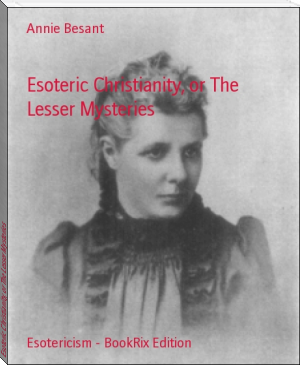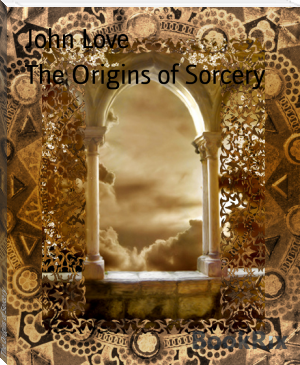Esoteric Christianity, or The Lesser Mysteries - Annie Besant (ebook reader that looks like a book .TXT) 📗

- Author: Annie Besant
Book online «Esoteric Christianity, or The Lesser Mysteries - Annie Besant (ebook reader that looks like a book .TXT) 📗». Author Annie Besant
Such mantras form an essential part of every Sacrament.
The next essential part of the Sacrament, in its outward and visible form, are certain gestures. These are called Signs, or Seals, or Sigils--the three words meaning the same thing in a Sacrament. Each sign has its own particular meaning, and marks the direction imposed on the invisible forces with which the celebrant is dealing, whether those forces be his own or poured through him. In any case, they are needed to bring about the desired result, and they are an essential portion of the sacramental rite. Such a sign is called a "Sign of Power," as the mantra is a "Word of Power."
It is interesting to read in occult works of the past references to these facts, true then as now, true now as then. In the Egyptian _Book of the Dead_ is described the _post-mortem_ journey of the Soul, and we read how he is stopped and challenged at various stages of that journey. He is stopped and challenged by the Guardians of the Gate of each successive world, and the Soul cannot pass through the Gate and go on his way unless he knows two things: he must pronounce a word, the Word of Power: he must make a sign, the Sign of Power. When that Word is spoken, when that Sign is given, the bars of the Gate fall down, and the Guardians stand aside to let the Soul pass through. A similar account is given in the great mystic Christian Gospel, the _Pistis Sophia_, before mentioned.[332] Here the passage through the worlds is not of a Soul set free from the body by death, but of one who has voluntarily left it in the course of Initiation. There are great Powers, the Powers of Nature, that bar his way, and till the Initiate gives the Word and the Sign, they will not allow him to pass through the portals of their realms. This double knowledge, then, was necessary--to speak the Word of Power, to make the Sign of Power. Without these progress was blocked, and without these a Sacrament is no Sacrament.
Further, in all Sacraments some physical material is used, or should be used.[333] This is ever a symbol of that which is to be gained by the Sacrament, and points to the nature of the "inward and spiritual grace" received through it. This is also the material means of conveying the grace, not symbolically, but actually, and a subtle change in this material adapts it for high ends.
Now a physical object consists of the solid, liquid, and gaseous particles into which a chemist would resolve it by analysis, and further of ether, which interpenetrates the grosser stuffs. In this ether play the magnetic energies. It is further connected with counterparts of subtle matter, in which play energies subtler than the magnetic, but like them in nature and more powerful.
When such an object is magnetised a change is effected in the ethereal portion, the wave-motions are altered and systematised, and made to follow the wave-motions of the ether of the magnetiser; it thus comes to share his nature, and the denser particles of the object, played on by the ether, slowly change their rates of vibration. If the magnetiser has the power of affecting the subtler counterparts also he makes them similarly vibrate in assonance with his own.
This is the secret of magnetic cures: the irregular vibrations of the diseased person are so worked on as to accord with the regular vibrations of the healthy operator, as definitely as an irregularly swinging object may be made to swing regularly by repeated and timed blows. A doctor will magnetise water and cure his patient therewith. He will magnetise a cloth, and the cloth, laid on the seat of pain, will heal. He will use a powerful magnet, or a current from a galvanic cell, and restore energy to a nerve. In all cases the ether is thrown into motion, and by this the denser physical particles are affected.
A similar result accrues when the materials used in a Sacrament are acted on by the Word of Power and the Sign of Power. Magnetic changes are caused in the ether of the physical substance, and the subtle counterparts are affected according to the knowledge, purity, and devotion of the celebrant who magnetises--or, in the religious term, consecrates--it. Further, the Word and the Sign of Power summon to the celebration the Angels specially concerned with the materials used and the nature of the act performed, and they lend their powerful aid, pouring their own magnetic energies into the subtle counterparts, and even into the physical ether, thus reinforcing the energies of the celebrant. No one who knows anything of the powers of magnetism can doubt the possibility of the changes in material objects thus indicated. And if a man of science, who may have no faith in the unseen, has the power to so impregnate water with his own vital energy that it cures a physical disease, why should power of a loftier, though _similar_, nature be denied to those of saintly life, of noble character, of knowledge of the invisible? Those who are able to sense the higher forms of magnetism know very well that consecrated objects vary much in their power, and that the magnetic difference is due to the varying knowledge, purity, and spirituality of the priest who consecrates them. Some deny all vital magnetism, and would reject alike the holy water of religion and the magnetised water of medical science. They are consistent, but ignorant. But those who admit the utility of the one, and laugh at the other, show themselves to be not wise but prejudiced, not learned but one-sided, and prove that their want of belief in religion biases their intelligence, predisposing them to reject from the hand of religion that which they accept from the hand of science. A little will be added to this with regard to "sacred objects" generally in Chapter XIV.
We thus see that the outer part of the Sacrament is of very great importance. Real changes are made in the materials used. They are made the vehicles of energies higher than those which naturally belong to them; persons approaching them, touching them, will have their own etheric and subtle bodies affected by their potent magnetism, and will be brought into a condition very receptive of higher influences, being tuned into accord with the lofty Beings connected with the Word and the Sign used in consecration; Beings belonging to the invisible world will be present during the sacramental rite, pouring out their benign and gracious influences; and thus all who are worthy participants in the ceremony--sufficiently pure and devoted to be tuned by the vibrations caused--will find their emotions purified and stimulated, their spirituality quickened, and their hearts filled with peace, by coming into such close touch with the unseen realities.
CHAPTER XIII.
SACRAMENTS (_continued_).
We have now to apply these general principles to concrete examples, and to see how they explain and justify the sacramental rites found in all religions.
It will be sufficient if we take as examples three out of the Seven Sacraments used in the Church Catholic. Two are recognised as obligatory by all Christians, although extreme Protestants deprive them of their sacramental character, giving them a declaratory and remembrance value only instead of a sacramental; yet even among them the heart of true devotion wins something of the sacramental blessing the head denies. The third is not recognised as even nominally a Sacrament by Protestant Churches, though it shows the essential signs of a Sacrament, as given in the definition in the Catechism of the Church of England already quoted.[334] The first is that of Baptism; the second that of the Eucharist; the third that of Marriage. The putting of Marriage out of the rank of a Sacrament has much degraded its lofty ideal, and has led to much of that loosening of its tie that thinking men deplore.
The Sacrament of Baptism is found in all religions, not only at the entrance into earth-life, but more generally as a ceremony of purification. The ceremony which admits the new-born--or adult--incomer into a religion has a sprinkling with water as an essential part of the rite, and this was as universal in ancient days as it is now. The Rev. Dr. Giles remarks: "The idea of using water as emblematic of spiritual washing is too obvious to allow surprise at the antiquity of this rite. Dr. Hyde, in his treatise on the _Religion of the Ancient Persians_, xxxiv. 406, tells us that it prevailed among that people. 'They do not use circumcision for their children, but only baptism, or washing for the purification of the soul. They bring the child to the priest into the church, and place him in front of the sun and fire, which ceremony being completed, they look upon him as more sacred than before. Lord says that they bring the water for this purpose in bark of the Holm-tree; that tree is in truth the Haum of the Magi, of which we spoke before on another occasion. Sometimes also it is otherwise done by immersing him in a large vessel of water, as Tavernier tells us. After such washing, or baptism, the priest imposes on the child the name given by the parents.'"[335] A few weeks after the birth of a Hindu child a ceremony is performed, a part of which consists in sprinkling the child with water--such sprinkling entering into all Hindu worship. Williamson gives authorities for the practise of Baptism in Egypt, Persia, Thibet, Mongolia, Mexico, Peru, Greece, Rome, Scandinavia, and among the Druids.[336] Some of the prayers quoted are very fine: "I pray that this celestial water, blue and light blue, may enter into thy body and there live. I pray that it may destroy in thee, and put away from thee, all the things evil and adverse that were given to thee before the beginning of the world." "O child! receive the water of the Lord of the world who is our life: it is to wash and to purify; may these drops remove the sin which was given to thee before the creation of the world, since all of us are under its power."
Tertullian mentions the very general use of Baptism among non-Christian nations in a passage already quoted,[337] and others of the Fathers refer to it.
In most religious communities a minor form of Baptism accompanies all religious ceremonies, water being used as a symbol of purification, and the idea being that no man should enter upon worship until he has purified his heart and conscience, the outer washing symbolising the inner lustration. In the Greek and Roman Churches a small receptacle for holy water is placed near every door, and every incoming worshipper touches it, making with it on himself the sign of the cross ere he goes onward towards the altar. On this Robert Taylor remarks: "The baptismal fonts in our Protestant churches, and we need hardly say more especially the little cisterns at the entrance of our Catholic chapels, are not imitations, but an unbroken and never interrupted continuation of the same _aqua minaria_, or _amula_, which the learned Montfaucon, in his _Antiquities_, shows to have been vases of holy water, which were placed by





Comments (0)